
The Slater Mill is a historic textile mill complex on the banks of the Blackstone River in Pawtucket, Rhode Island, modeled after cotton spinning mills first established in England. It is the first water-powered cotton spinning mill in North America to utilize the Arkwright system of cotton spinning as developed by Richard Arkwright.

The John Brown House is the first mansion built in Providence, Rhode Island, located at 52 Power Street on College Hill where it borders the campus of Brown University. The house is named after the original owner, one of the early benefactors of the University, merchant, statesman, and slave trader John Brown. It was declared a National Historic Landmark in 1968. John Quincy Adams considered it "the most magnificent and elegant private mansion that I have ever seen on this continent."
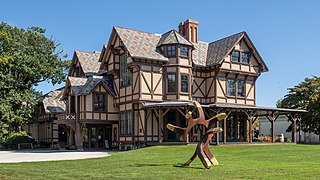
The John N. A. Griswold House is a historic house located at 76 Bellevue Avenue in Newport, Rhode Island. It was built in 1864 for John Noble Alsop Griswold, an Old China Trade merchant and member of the Griswold Family, and was designed by Richard Morris Hunt in the American Stick style, one of the earliest buildings in that style, and one of Hunt's first works in Newport.

The James Dennis House is an historic house located at 3120 Pawtucket Avenue in East Providence, Rhode Island. This two-story wood-frame house was built sometime in the 1870s, and is a fine local example of Queen Anne Victorian style. Its most prominent features are a square tower with pyramidal roof, and a decorated porch that wraps around three sides. Although Pawtucket Avenue once had a significant number of such houses lining it, most have been demolished or significantly altered.

The Arnold–Palmer House is an historic house at 33 Chestnut Street in Providence, Rhode Island. The Federal style house was built in 1826 for wealthy Providence merchant Daniel Arnold at a location on upper Westminster Street, where it was one of four nearly identical houses whose design was attributed to prominent local architect John Holden Greene by preservationist Norman Isham. This house is the only one of the four still standing, having been moved to its present location in 1967 as part of the Weybosset Hill urban redevelopment project.

Art's Auto is a historic former service station at 5–7 Lonsdale Avenue in Pawtucket, Rhode Island. It is a single-story brick structure with a flat roof and a series of towers capped by pointed roofs. It was erected as an automotive service station in 1927–28 for Arthur Normand at a time when gasoline producers competed, in part, by the shape and style of their service stations. This station is one of two stations known to survive from this period in the state. Its front facade has a dramatic presentation, with square towers topped by pyramidal roofs at the corners, and a projecting round bay in the center topped by a conical roof, with windows arrayed around the bay and on its flanks. The building is currently used as an office for Anchor Financial. Art's Auto was listed on the National Register of Historic Places in 1978.

The Bridge Mill Power Plant is an historic hydroelectric plant at 25 Roosevelt Avenue in Pawtucket, Rhode Island. It is a red brick building, with sections two and three stories in height, located on the west bank of the Seekonk River. An ashlar granite retaining wall obscures a conduit which delivers water to the facility from the Pawtucket Falls Dam. The facility has three parts: a gate house, which controls the flow of water into the power house, where five turbines were located. A boiler house housed a steam generation facility which was used to generate power when the water levels were too low for hydroelectric power generation. Built in 1893, this is probably the best-preserved 19th-century hydroelectric power station in Rhode Island.
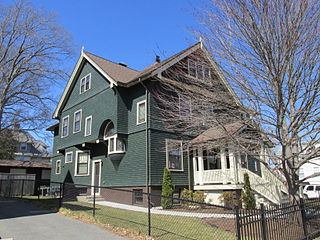
The E. A. Burnham House is an historic house at 17 Nickerson Street in Pawtucket, Rhode Island. It is a 2+1⁄2-story wood-frame structure, with a cross-gabled hip roof plan. Its exterior is finished in wood shingles, with decorative Gothic Revival bargeboard, finials, and other elements. The building's interior contains elaborately carved woodwork, most of which has survived conversion of the building to multiple units. The house was built in 1902 for Eugene Burnham, a local businessman, and is one of the few known designs of local architect Albert H. Humes. The property's garage, which is stylistically similar to the house, may be one of the oldest in the city.
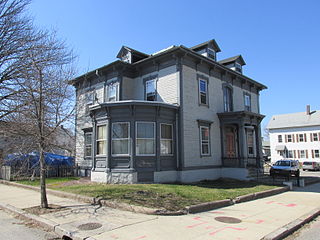
The Childs–Brown House is an historic house in Pawtucket, Rhode Island. It is a two-story wood-frame structure, roughly square in shape, with a low-pitch hipped roof broken by dormer roofs. An ell extends to the rear of the house. Both the eaves and the roof of the front porch exhibit heavy brackets typical of the Italianate style. The interior also retains Italianate style in its woodwork, most prominently in the semi-elliptical main stairway. Built in 1868–69 for Alfred L. Childs, an ice dealer, it was for a number of years owned by members of the Brown family prominent in Rhode Island civic and economic life.

The Fifth Ward Wardroom is a historic meeting hall at 47 Mulberry Street in Pawtucket, Rhode Island. It is a single-story red brick building, with a low-pitch hipped roof. Basically rectangular, an enclosed entry pavilion projects from the main block. The building was designed by William R. Walker & Son and built in 1886. Originally used as a polling place and meeting hall, it was later used as a school and by veterans organizations before being converted into a single family residence during its National Register of Historic Places nomination. It was listed on the historic register in 1983.
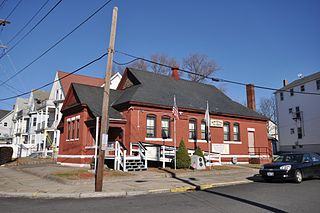
The First Ward Wardroom is a historic meeting hall at 171 Fountain Street in Pawtucket, Rhode Island. It is a single-story red brick building, with a low-pitch gable-over-hipped roof. Basically rectangular, an enclosed entry pavilion projects from the main block. The building, designed by William R. Walker & Son and built in 1886, is one of only three ward halls to survive in the state. Since about 1920 it has been the Major Walter G. Gatchell Post No. 306 of the Veterans of Foreign Wars. The building was listed on the National Register of Historic Places in 1983.

The Foster–Payne House is a historic house at 25 Belmont Street in Pawtucket, Rhode Island. Built in 1878, the two-story multi-gabled house is distinguished by its clapboarded and exterior woodwork and opulent parlors in the interior. The property also has a matching carriagehouse with gable roof and cupola. The house was originally constructed and owned by Theodore Waters Foster, but it was sold to George W. Payne in 1882. The Foster–Payne House is architecturally significant as a well-designed and well-preserved late 19th century suburban residence. It was added to the National Register of Historic Places in 1983.

The Mitchell–Arnold House is a historic house located in Pawtucket, Rhode Island.

Pawtucket City Hall is located at 137 Roosevelt Avenue, just outside the central business district of Pawtucket, Rhode Island. The Art Deco-style building was designed by Providence architect John O'Malley and was built in 1933–1936, its cost subsidized by funds from the Works Progress Administration.

The Pitcher-Goff House, is an historic house at 58 Walcott Street in the Quality Hill neighborhood of Pawtucket, Rhode Island. The house is architecturally eclectic, with a largely Italianate exterior, and a Late Victorian interior. The house was built for Elias B. Pitcher, a cotton textile manufacturer, in 1840. Later it was sold to Lyman B. Goff, another local industrialist, who made significant alterations to the interior, replacing a great deal of the older woodwork with more fashionable Queen Anne styling in 1881. He also modified the exterior, but these changes were largely limited to the porch, which also exhibits fine Queen Anne detailing.

The Scholze–Sayles House is a historic house in Pawtucket, Rhode Island. It is a 1+1⁄2-story wood-frame structure, built in 1874–75. It is one of two built by the German Land Cooperative Association, which sought to create a German-speaking enclave in the area. This house is a fine example of Gothic Revival style, and is stylistically similar to the Kotzow House, with a busy exterior that has numerous projecting and gabled sections, and Stick style decoration on a bay window. The interior was extensively redone in 1935 in a Federal Revival style by architect Albert Harkness.

St. Mary's Church of the Immaculate Conception Complex is an historic Roman Catholic church complex at 103 Pine Street in Pawtucket, Rhode Island.
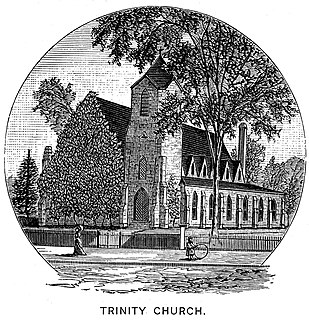
Trinity Episcopal Church was a historic church located at 48 Main Street in Pawtucket, Rhode Island. Built by the Episcopalians, the building was sold to the Catholics in 1977 and became the St. George Maronite Catholic Church within the Diocese of Providence. The church burned down in 2005, and was not rebuilt.

The Herbert A. Sadler House is a historic house located at 574 Newport Avenue in Attleboro, Massachusetts. Built in 1906, it is one of the city's most elaborate examples of Colonial Revival architecture. It was built for Herbert Sadler, the owner of Sadler Brothers, one of the city's leading jewelry firms of the period. The house was listed on the National Register of Historic Places on October 21, 1982. It now houses an assisted living facility.

The William B. Spencer House is a historic house at 11 Fairview Avenue in the Phenix village of West Warwick, Rhode Island. The 2+1⁄2-story wood-frame house was built in 1869–70, and is an elaborate and well-preserved instance of Late Victorian Italianate style. The house has an L shape, with forward projecting gable section on the left, in front of a rectangular main block. A single-story porch with slender columns and decorative woodwork valances extends across the front to the right of the projecting section. The windows on the projecting section are three-part rounded windows, each with distinctive and elaborate hoods. The building corners are quoined, and the roofline features dentil moulding and paired brackets. A series of smaller ells project to the right of the main block, and there is a small single-story addition to the rear. The main block is topped by an octagonal cupola with round-arch windows. The building's owner, William B. Spencer, was a local entrepreneur who made his fortune by dealing in the waste materials generated by the local cotton mills.






















